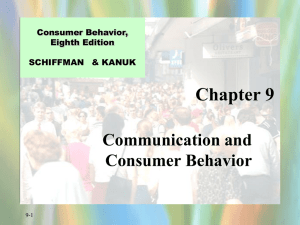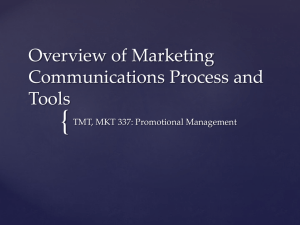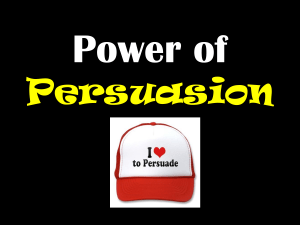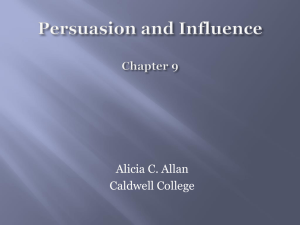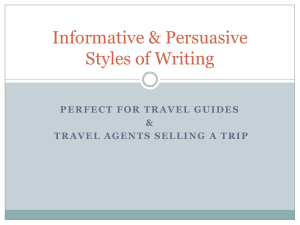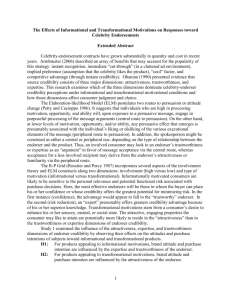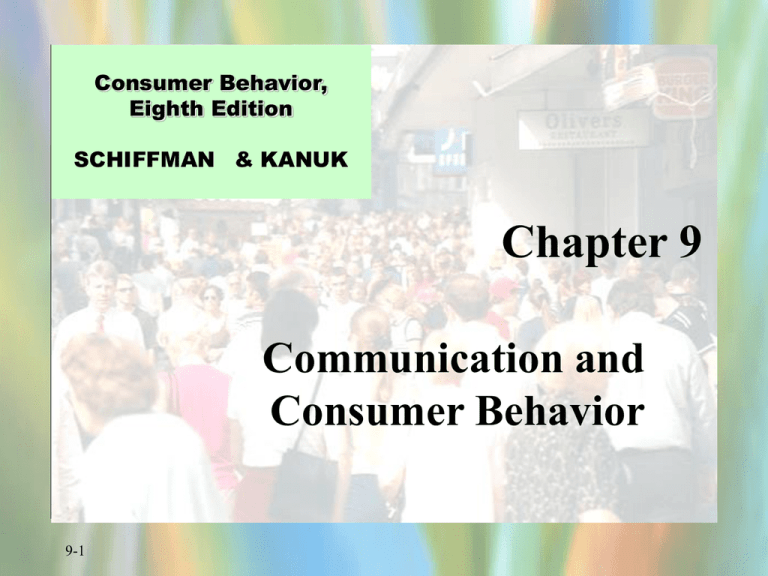
Consumer Behavior,
Eighth Edition
SCHIFFMAN & KANUK
Chapter 9
Communication and
Consumer Behavior
9-1
Figure 9.1 Basic Communication Model
Sender
(Source)
Channel
(Medium
)
Message
Feedback
9-2
Receiver
(Consumer)
Elements of the
Communications Process
•
•
•
•
•
•
•
9-3
The Message Initiator (the Source)
The Sender
The Receiver
The Medium
The Message
The Target Audience (the Receivers)
Feedback - the Receiver’s Response
Figure 9.2 Ad
Depicting NonVerbal
Communication
9-4
Issues in Credibility
• Credibility of Informal Sources
• Credibility of Formal Sources
• Credibility of Spokespersons and Endorsers
( supporters )
• Message Credibility
9-5
Endorser Credibility
• Endorser credibility is important when
message comprehension is low
• Match must exist between product attributes
and endorser attributes
• Credibility is higher when endorser’s
demographic characteristics are similar to
those of target audience
• Endorser credibility is not a substitute for
corporate credibility
9-6
Sleeper
Effect
9-7
The idea that both
positive and negative
credibility effects tend
to disappear after a
period of time.
Barriers to Communication
• Selective Perception
– Wandering, Zipping, and Channel Surfing
– Combat with Road blocking (overcrowding)
• Psychological Noise
– Combat with repeated exposures, contrast in the
copy, and teasers
9-8
Figure 9.3 Comprehensive
Communication Model
Commercial Verbal vs. Nonverbal
Non-Profit
1-sided vs. 2-sided
Individual Factual vs. Emotional
Formal vs.
Informal
Messag
e
Sender
(Source)
Symbols
Pictures
Words
Images
Selective
Exposure
Individuals
Target Audience
Intermediary Audience
Unintended Audiences
Channel
(Medium
)
Decodes
Paid vs. Unpaid
Print, Broadcast, Electronic
Personal vs. Impersonal
Pretests to Ensure Message Will be Received
Posttests to Ensure Message Was Received
9-9
Receiver
(Consumer)
Mediated by:
Involvement
Mood
Experience
Personal Charac.
Feedback
Responds
Appropriately
?
No
Miscomprehends
?
No
Yes
Yes
Issues in Designing Persuasive
Communications
• Communications strategy
• Media strategy
• Message strategy
9-10
Communications Strategy
Memory
Perceptions
Experience
9-11
Figure 9.4 Perception/ Experience/
Memory Model of Advertising
Pre-experience Exposure
(phase)
Post-experience Exposure
(phase)
Framing (ftn)
Perception
Enhancing
Experience
Organizing
Memory
Expectation (effect)
Anticipation
Interpretation
Sensory
Enhancement
Social
Enhancement
Cueing
Branding
Interpretation
9-12
Media Strategy
• Consumer profiles
• Audience profiles
A cost-effective media choice is one
that closely matches the
advertiser’s consumer profile
with the medium’s audience profile.
(tailoring your message to audience needs)
9-13
Excerpts from Table 9.2 Persuasive
Capabilities and Limitations of Major
Media (Newspaper)
•
•
•
•
•
9-14
Access to large audiences
Effective for local reach
Flexible
Fast
Feedback possible
through coupon
redemption (release), etc.
• Not selective
• Short message life
• Clutter
(confusion/disorder)
• Cost varies based on
ad size and circulation
Excerpts from Table 9.2 Persuasive
Capabilities and Limitations of Major
Media (Magazines)
•
•
•
•
•
•
9-15
Highly selective
Selective binding possible
High quality production
High credibility
Long message life
High pass along rate
• Long lead time
• High clutter
• Delayed and indirect
feedback
• Rates vary based on
circulation and
selectivity
Excerpts from Table 9.2 Persuasive
Capabilities and Limitations of Major
Media (Television)
• Large audiences possible
• Appeals to many senses
• Emotion and attention
possible
• Demonstration possible
• Very high costs overall
9-16
•
•
•
•
Long lead time
High clutter
Short message life
Viewers can avoid
exposure with
zapping, etc.
• Day-after recall tests
for feedback
Excerpts from Table 9.2 Persuasive
Capabilities and Limitations of Major
Media (Radio)
• High geographic and
demographic selectivity
• Short lead time
• Relatively inexpensive
• Good local coverage
9-17
•
•
•
•
•
Short exposure time
Audio only
High clutter
Zapping possible
Delayed feedback
through day-after
recall tests
Excerpts from Table 9.2 Persuasive
Capabilities and Limitations of Major
Media (Internet)
• Potential for audience
selectivity
• Customized tracking
possible and other
feedback tools possible
• Useful for branding and
reinforcement of
messages
9-18
• Demographic skew to
audience
• Very high clutter
• Zapping possible
• Great variation in
pricing
• Privacy concerns
Excerpts from Table 9.2 Persuasive
Capabilities and Limitations of Major
Media (Direct Mail)
• High audience selectivity • Perception of junk
mail
• Personalization possible
• Novel, interesting stimuli • Feedback possible
through response
possible
• High cost per contact
• Low clutter
9-19
Excerpts from Table 9.2 Persuasive
Capabilities and Limitations of Major
Media (Direct Marketing)
• Development of
• Privacy concerns
databases
• Measurable responses
• High audience selectivity • Cost per inquiry, cost
• Relatively free of clutter
per sale, revenue per
ad can be calculated
9-20
Table 9.3 Buyer Personalities and
Advertising Strategies
Righteous
Social
Pragmatic
How might advertising be designed
for these three distinct buyer types?
9-21
Involvement Theory and Persuasion
The Elaboration Likelihood Model (ELM)
proposes that marketers use the
•central route to persuasion for high
involvement products and the
•peripheral route to persuasion for low
involvement products
9-22
Figure 9.5
Central Route
to Persuasion
9-23
Issues in Message Presentation
•
•
•
•
•
•
9-24
Resonance
Message Framing
One-sided Versus Two-sided Messages
Comparative Advertising
Order Effects
Repetition
Figure 9.6
Resonance
in
Advertising
9-25
Figure 9.7
Two-Sided
Appeal
9-26
Figure 9.8 Comparative Advertising
9-27
Figure 9.9
Comparative
Advertising
9-28
Emotional Advertising Appeals
Fear
Humor
Abrasive advertising
Sex in advertising
Audience participation
9-29
Figure 9.10
Humor to
Baby Boomers
9-30
Figure 9.11
Sexual
Appeal
9-31
Table 9.4 Impact of Humor on Advertising
•Humor attracts attention.
•Humor does not harm comprehension.
•Humor is not more effective at increasing persuasion.
•Humor does not enhance source credibility.
•Humor enhances liking.
•Humor that is relevant to the product is superior to humor that is
unrelated to the product.
•Audience demographic factors affect the response to humorous
advertising appeals.
•The nature of the product affects the appropriateness of a humorous
treatment.
•Humor is more effective with existing products than with new
products.
•Humor is more appropriate for low-involvement products and feelingoriented products than for high-involvement products.
9-32

